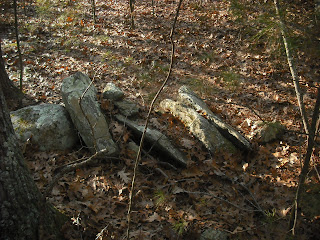Somewhere in northern Rhode Island is a large patch of preservation land with some small ponds and wetland. On a warm Saturday afternoon in January, I was walking there and I noticed these two manitous to the west of the trail.
These turned out to be the end of a stone row that ran about 170 feet to the south.
This standing slab style is common in stone rows in northern Rhode Island. Most of the wall was loose stones with an occasional manitou. It did not connect with any other walls.
Further north in the same site is another wall, which starts at a large boulder with a strong resemblance to a snake head.
This well built wall runs about 207 feet nearly north, and has interspersed quartz stones.
It ends in loose piles of rocks on a small hill.
On top of the hill is this natural structure. Some veins of quartz are visible on the other side.
The wall seems to connect this natural structure to the snake head boulder. The snake head faces a nearby pond.
I have seen single stone rows incorporating remarkable boulders at other sites in RI. They are often at the edges of slopes and meadow areas that could have been cultivated by the Indians. The walls could have been boundary markers, and incorporated the symbols of the clan using the fields. Snakes could also have been fertility symbols.









Are you sure image 7 is completely natural? The grain of this stone cluster is verical, yet the terrain reads horizontal. A geologist should have a closer look at this structure.
ReplyDelete